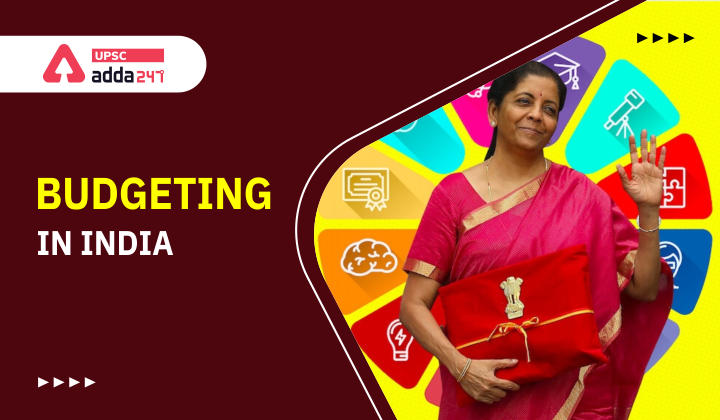Table of Contents
Relevance
”GS 3 & GS 2: Government Budgeting, Parliament, Executive”
Context
- With the economy still hurting from the pandemic, the Budget on February 1 will be crucial to deal with concerns around growth, inflation and spending.
- The Budget, which will be tabled in Parliament by Finance Minister Nirmala Sitharaman, is the Government’s blueprint on expenditure, taxes it plans to levy, and other transactions which affect the economy and the lives of citizens.
Major Components of Budget
- There are three major components of the Budget —expenditure, receipts and deficit indicators.
- Further, there can be many classifications and indicators of expenditure, receipts and deficits.
- Total expenditure can be further be divided into capital and revenue expenditure.
- Depending on the manner in which they are defined, there can be many classifications and indicators of expenditure, receipts and deficits.
- Similarly, the receipts of the Government also have three components —revenue receipts, non-debt capital receipts and debt-creating capital receipts while fiscal deficit means the difference between total expenditure and the sum of revenue receipts and non-debt receipts.
- Since different components of expenditure and revenue can have different effects on the income of different classes and social groups, the Budget has implications for income distribution as well.
About N.K. Singh Committee
- Fiscal rules provide specific policy targets on the basis of which fiscal policy is formed. Policy targets can be met by using different policy instruments. There exists no unique fiscal rule that is applied to all countries. Rather, policy targets are sensitive to the nature of economic theory and depend on the specificity of an economy.
- In India, the fiscal rule is guided by the recommendations of the N.K. Singh Committee Report.
- Allowing for some deviations under exceptional times, it has three policy targets —maintaining a specific level of debt-GDP ratio (stock target), fiscal deficit-GDP ratio (flow target) and revenue deficit-GDP ratio (composition target).
What are the different kinds of Budget Expenditure?
- Based on their impact on assets and liabilities, total expenditure can be divided into capital and revenue expenditure.
- Capital expenditure is incurred with the purpose of increasing assets of a durable nature or of reducing recurring liabilities. For example, construction of new schools or new hospitals.
- Revenue expenditure involves any expenditure that does not add to assets or reduce liabilities. Expenditure on the payment of wages and salaries, subsidies or interest payments would be typically classified as revenue expenditure.
- The sum of expenditure on economic and social services together form the development expenditure. Economic services include expenditure on transport, communication, rural development, agricultural and allied sectors. Expenditure on the social sector including education or health is categorised as social services.
- Again, depending on its effect on asset creation or liability reduction, development expenditure can be further classified as revenue and capital expenditure.
What are the different kinds of Receipts?
- The receipts of the Government have three components — revenue receipts, non-debt capital receipts and debt-creating capital receipts.
- Revenue receipts- Receipts that are not associated with increase in liabilities and comprise revenue from taxes and non-tax sources.
- Non-debt receipts– These are part of capital receipts that do not generate additional liabilities. Recovery of loans and proceeds from disinvestments would be regarded as non-debt receipts since generating revenue from these sources does not directly increase liabilities or future payment commitments.
- Debt-creating capital receipts– Ones that involve higher liabilities and future payment commitments of the Government.
What is a Fiscal deficit?
- It is the difference between total expenditure and the sum of revenue receipts and non-debt receipts.
- It indicates how much the Government is spending in net terms.
- Since positive fiscal deficits indicate the amount of expenditure over and above revenue and non-debt receipts, it needs to be financed by a debt-creating capital receipt.
What is a Primary deficit?
- A primary deficit is a difference between fiscal deficit and interest payments.
- It shows the government’s borrowings to meet interest payments.
- A shrinking primary deficit points to the recovering fiscal health of an economy.
What is a Revenue deficit?
- When total revenue expenditure exceeds total revenue receipts it leads to a revenue deficit.
- So, the Revenue deficit is derived by deducting capital expenditure from fiscal deficits.
- It shows a shortage of funds with the government to maintain its day-to-day affairs.
What are the implications of the Budget on the economy?
- Implication for aggregate demand of an economy as all Government expenditure generates aggregate demand in the economy.
- Reduction in expenditure GDP ratio or increase in revenue receipt-GDP ratio indicates the Government’s policy to reduce aggregate demand and vice-versa.
- For similar reasons, reduction in fiscal deficit-GDP ratio and primary deficit-GDP ratios indicate Government policy of reducing demand and vice versa.
- Since different components of expenditure and revenue can have different effects on the income of different classes and social groups, the Budget also has implications for income distribution. For example, revenue expenditure such as employment guarantee schemes or food subsidies can directly boost the income of the poor.
- Concession in corporate tax may directly and positively affect corporate incomes.



 TSPSC Group 1 Question Paper 2024, Downl...
TSPSC Group 1 Question Paper 2024, Downl...
 TSPSC Group 1 Answer key 2024 Out, Downl...
TSPSC Group 1 Answer key 2024 Out, Downl...
 UPSC Prelims 2024 Question Paper, Downlo...
UPSC Prelims 2024 Question Paper, Downlo...




